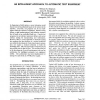Free Online Productivity Tools
i2Speak
i2Symbol
i2OCR
iTex2Img
iWeb2Print
iWeb2Shot
i2Type
iPdf2Split
iPdf2Merge
i2Bopomofo
i2Arabic
i2Style
i2Image
i2PDF
iLatex2Rtf
Sci2ools
ITC
1991
IEEE
1991
IEEE
An Intelligent Approach to Automatic Test Equipment
In diagnosing a failed system, a smart technician would choose tests to be performed based on the context of the situation. Currently, test program sets do not fault-. isolate within the context of a situation. Instead, testing follows a rigid, predetermined, fault-isolation sequence that is based on an embedded fault tree. Current test programs do not tolerate instrument failure and cannot redirect testing by incorporating new information. However, there is a new approach to automatic testing that emulates the best features of a trained technician yet, unlike the development of rule-based expert systems, does not require a trained technician to build the knowledge base. This new approach is model-based and has evolved over the last 10 years. This evolution has led to the development of several maintenance tools and an architecture for intelligent automatic test equipment (ATE). The architecture has been implemented for testing two cards from an AV-8B power supply.
| Added | 27 Aug 2010 |
| Updated | 27 Aug 2010 |
| Type | Conference |
| Year | 1991 |
| Where | ITC |
| Authors | William R. Simpson, John W. Sheppard |
Comments (0)

